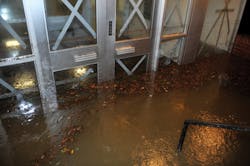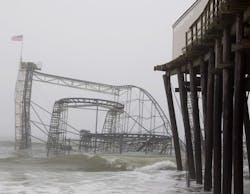In a span of less than 24 hours last October, residents of metro New York City were rudely reminded of how very close they live to the water — maybe, it now seems, a little too close for comfort.
Hurricane Sandy, dubbed a “superstorm” for its sheer size and reach in punishing the Northeast, took dead aim on the New York/New Jersey metropolis, merging torrential rains with waters of the Atlantic to flood low-lying boroughs and a broad stretch of coastline on a scale not seen in decades.
Among the many victims in the water’s path were emergency back-up power systems in a range of environments — from health-care facilities and data centers to office buildings and residential structures. In the worst cases, some systems were swamped, rendering gen-sets useless or too unpredictable to rely on in a critical hour of need. In others, they were temporarily disabled, leading to mere inconvenience.
Regardless of the venue, the inability of some systems to answer the call — and the problems that followed — has sounded some alarm bells in the industry. New concerns are sprouting that perhaps fundamental assumptions used to design and install back-up power in some applications and locations may be fundamentally flawed.
Challenging assumptions
Fearing that Sandy may foreshadow new weather patterns that could spawn more surprise and possibly unprecedented flooding events, building owners, engineers, gen-set manufacturers, systems designers, government officials, and code authorities may be poised to start revisiting best practices and requirements for back-up power systems.
For Bill Burke, division manager for the National Fire Protection Association (NFPA), the storm’s fury and its impact on the electrical power infrastructure was crystallized in a dramatic newsmagazine cover photo showing a largely blacked-out Lower Manhattan in the storm’s wake. Remarking on it with colleague Don Bliss, chairman of National Electrical Code (NEC )Code-Making Panel 13, which establishes emergency power system provisions in the NEC, they both agreed it was a stark and telling image.
“Being electrical people, we were struck by the same things in that cover showing a darkened skyline, especially the realization that every one of those buildings probably had some kind of requirement or provision for back-up power, yet many of them apparently hadn’t worked,” Burke says.
While that photo was revealing, likely hundreds of facilities across the metro area did indeed have emergency power that ultimately worked as designed, even after experiencing temporary glitches in some cases. So, in that sense, the image may have overstated the extent and impact of the actual blackout and its duration.
Nevertheless, Sandy’s floodwaters did find vulnerable systems in places that could least afford power interruptions of any duration. Now, four months later, those failures stand as fresh proof that back-up power is ultimately only as good as its ability to stand up to the most extreme circumstances, particularly in mission-critical environments.
Vulnerable venues
Understandably, the Sandy-induced back-up power system failures that captured the most attention for both their real and potential impact were those that plagued a few important hospitals in low-lying parts of New York City.
Problems like those faced at facilities like New York University Langone Medical Center (NYU Langone), Bellevue Hospital Center, and Coney Island Hospital, as well as other buildings scattered across several boroughs, largely shared a common theme. Where back-up power systems failed, most, if not all, apparently succumbed because floodwaters overwhelmed fuel pumps, transfer switches, or other essential equipment housed on lower levels. The problem was many of these units needed to power generators that were sitting on upper floors. Many of the 6,000-patient evacuations from metro area hospitals likely stemmed from power interruptions or losses (see Hospital System Design Debate).
Storm surges of 11 feet in most areas of the city and up to 14 feet in others sent water cascading into the lower levels of buildings. Many were constructed to withstand some water inundation, but generally not at the levels Sandy delivered. Some reports put peak water volumes in some basements upward of 15 million gallons.
Of all the New York-area facilities that suffered back-up power problems, NYU Langone may have received the most attention. Located on the banks of the East River in Manhattan, parts of the NYU Langone medical complex (consisting of four hospitals) experienced flooding, and parts of some buildings lost emergency power provided by on-site generators.
According to one published report quoting the hospital’s vice president of facilities operations, in places floodwaters under extremely high pressure overwhelmed protective barriers surrounding pumps that shuttle fuel to multiple emergency generators, causing them to shut down. With fuel supplies cut — and critical power distribution circuits also compromised by exposure to water — some generators were rendered ineffective or operationally suspect, leaving or threatening to leave multiple areas of the complex powerless as the storm bore down.
Some pump operations were quickly restored, but hospital officials decided to take the precautionary step of evacuating patients. Because of flooding in the basement level that made the elevators unsafe to operate, the hospital brought patients down stairwells. Outside, where the storm raged, ambulances queued up to ferry them to other facilities. In all, more than 300 patients were safely evacuated.
Seeking answers
Responding in late January to these early published reports and specific questions from EC&M, NYU Langone appeared to distinguish between generator failure and the failure of pumps and other related components, but did not address the latter.
Specifically, the hospital said in written responses that only one of its eight campus generators actually failed. That unit, the only one below ground level (which provides less than 5% of the campus’ generator capacity) did sustain water damage. But since it did not serve any patient care or critical research areas, the hospital said its failure “did not result in significant power outages and did not lead to the evacuation of patients.”
Addressing only the center’s Tisch Hospital for acute care patients, and no others, NYU Langone said generators serving that facility did not fail and supplied power to “several hospital floors” during the storm.
“Our investigation into the cause of the power outage at Tisch Hospital is ongoing, and it is too early to speculate as to what caused certain floors within the hospital to experience the power outage,” the statement read.
While details of what happened at NYU Langone remain unclear, it is certain that on some level the hospital’s back-up power system did not perform optimally — and the failures that occurred did so even after work had apparently begun to re-engineer the system to better handle potential flooding.
Fixes weren’t enough
Following Hurricane Irene in 2011, the hospital reportedly scaled back and hardened the back-up power system’s street-level components. Generators were moved to the rooftop, fuel tanks were repositioned, and ground-level pumps connected to an underground fuel tank were cordoned off in a flood-resistant structure. According to reports, Sandy struck as the hospital was trying to secure funding for the next phase of system improvements aimed at further hardening it against storm-related threats, exposing the inadequacy of the patchwork improvements to the system and its continued vulnerability to flooding.
When questioned about efforts to ensure there would not be a repeat of back-up power problems, NYU Langone told EC&M that a $250-million co-generation natural gas power plant is under construction, and that flood barriers for that building and others are being considered.
That structure, the hospital said, will provide 8MW of additional power generation, enough to “mitigate potential outages and damages sustained from future storms.” As an additional precaution, back-up generators and components will operate 20 feet above code requirements.
Factoring floods into future designs
In Sandy, back-up systems failed across the metropolis for various reasons and to varying degrees. But their apparent vulnerability to flooding events, because of either location, design, or both, is worrisome to those who study emergency power systems. Studies, hearings, and investigations into why will likely loom. But the sheer number of apparent failures, combined with the venues in which they occurred, leaves some wondering if a fundamental rethinking is in order for applications where flooding is a risk.
With early indications that emergency power failures were rooted in failures of pumps and other systems that deliver fuel, generators themselves aren’t likely to emerge as the culprit. Provided they’re maintained, tested, kept in good operational condition, and located on higher ground — shielded from all but the most catastrophic water incursion — gen-sets should perform in typical storm scenarios.
The concern, says Michael Pope, current president of the Electrical Generating Systems Association (EGSA), an
organization that represents gen-set manufacturers, now likely centers on the design and location of enabling components of back-up power systems.
“The positioning of pumps and fuel supplies has to be reconsidered, and part of the problem in New York may be that the building codes don’t permit fuel storage on building roofs,” Pope figures. “If that’s the case, then every installation where fuel is stored below grade probably needs to be reviewed and looked at to determine if water can get in there and, if so, what precautions can be taken to prevent that from happening.”
While such an assessment may be an important first step, the looming question is whether Sandy may have been a game-changer. If the flooding it spawned resets the calculation of expected future high-water levels in lower-lying areas, remedial fixes may not be possible for many systems located at street level or lower.
Re-design challenges
With Sandy, and Irene before it, amping up the debate over climate change and the prospect of more powerful and more frequent storms, reasonable gauges of future high water marks might be ratcheted up. If so, as NYU Langone learned with its system improvements, it may not be realistic to think about protecting systems already in place from flooding that could accompany stronger storms.
Consequently, some, like engineers in the New York-based consulting engineering firm Syska-Hennessy Group, Inc., anticipate a fair amount of hand-wringing over how to configure back-up power systems in Sandy’s aftermath. In surveying the post-Sandy landscape and working with some clients in the city, among them health-care institutions, vice presidents Keith Fitzpatrick and Marina Dishel see a litany of concerns.
For one, if an expected new flood map of the city raises the 100-year flood mark by three or four feet, Fitzpatrick says, many existing back-up systems will be situated too low for comfort. But, as always is the case in disaster planning, it will come down to a question of how much risk to shoulder.
“Some landlords are replacing systems right where they were destroyed as if nothing happened, and others are thinking about moving everything up, at great cost, a floor or two higher,” says Fitzpatrick. “Clients who can’t afford that are thinking about constructing bathtubs of sorts around components to seal them off and rely on sump pumps in hopes of minimizing the risk. But for some of the buildings on the waterfront, there’s no way that pumps could have pumped as much water out as came in.”
Then there’s the problem of existing city building codes that dictate rules on emergency power system integration and, more relevantly, where and how much diesel fuel can be stored on-site, says Dishel.
“A lot of buildings will probably be looking to at least elevate pumps above flood level, if possible, but depending on the architecture of the system and the building that can be costly,” she says. “We’re working on redesigns like that for some clients, and we’ve also looked into submersible pumps, which don’t now look to be an option. Another solution could be dual-fuel (natural gas/oil) generators, but we’re not sure if the industry now provides the type of generator that would be needed.”
In search of best practices
Indeed, a broad slate of options for improving the reliance of back-up systems will likely be on the table as the Sandy experience is further analyzed. Bliss, the NEC Code-Making Panel 13 chairman and a professional emergency management expert, says revised calculations about flooding risk should probably be factored into assessments of the readiness of systems in flood-prone areas.
“There are some lessons to be learned here about preparedness, and there will be multiple components to study, including code compliance, the performance design/risk assessment process, how systems are designed and installed, specific needs for back-up power, and operational and human factors,” says Bliss.
Information on those and other elements of the back-up power experience in Sandy are due to be gathered by NFPA. Panels like Bliss’ and others who oversee parts of the NEC covering emergency power systems are keenly interested in understanding just how well such systems in Sandy’s path performed.
The mission, according to NFPA’s Burke, will be to draft a formal study that could inform efforts to update or change the many parts of the Code addressing back-up power. It’s too early to say whether changes to requirements are needed, but Burke says anecdotal information about failures suggest a need to study revisions. If critical systems are deemed more vulnerable to water because of where they’re housed or because geography conveys a heightened risk of more frequent and more powerful storms, remedies must be explored, he says.
“There may be better ways to install systems to protect against this sort of thing,” says Burke. “We need to find out why so many appear to have failed, try to categorize our findings into some very specific areas, and then take a logical look at maybe doing something better to prevent something like this from happening again.”
Zind is a freelance writer based in Lee’s Summit, Mo. He can be reached at [email protected].
SIDEBAR: Hospital System Design Debate
Emergency power reliability at health-care facilities has long been a topic of debate. After Hurricane Sandy, that conversation may be heating up even more.
Hospital back-up power is governed by an array of rules, regulations, and guidelines, many rooted in parts of the National Electrical Code (NEC). Location-specific design, testing, and maintenance are addressed in NFPA 99 – Healthcare Facilities; broad guidelines are covered in NFPA 110 – Emergency and Standby Power Systems. The chief hospital accrediting body, The Joint Commission, references both in its requirements for back-up power.
As comprehensive and detailed as these are, there may be gaps. Proclaimed skeptics of hospital readiness point to the flooding of back-up systems in Sandy as evidence. One, Arthur Kellerman, the policy chair at Rand Corp., was quoted by ProPublica as saying it was “remarkable” that the major hospitals still have critical back-up systems located in basements prone to flooding.
George Mills, director of engineering for the Joint Commission, says hospitals have some discretion in how they configure and place back-up systems, though some code wording does opaquely reference flood protection. They must rigorously and routinely test their systems for reliability, but a detailed hazard vulnerability analysis (HVA) typically governs system design and installation.
“Each organization needs to look at the HVA and see how to manage their systems through that,” he says. “Hospitals generally have to identify the risks they perceive to the public and then work to mitigate that risk.”
Designing for natural disasters, however, can be tricky. Threats vary based on geography, climate, and weather history, Mills says. But unprecedented events, similar to Sandy, can alter risk assessments. Following Hurricane Katrina, the Joint Commission issued an alert of sorts that advised locating back-up systems above expected flooding levels. But hospitals, he says, have to consider risk-benefit scenarios and weigh the costs of relocating systems or designing new ones that may be more costly to install. Post-Sandy, Mills says, some New York-area hospitals did engage in some second-guessing.
“Some said they wished they had maybe done a more thorough job looking at HVA assumptions,” he says. “But the theorem we go by here is that organizations appear to pay attention to the most recent events. If they haven’t experienced flooding, that’s low on their radar.”
About the Author
Tom Zind
Freelance Writer
Zind is a freelance writer based in Lee’s Summit, Mo. He can be reached at [email protected].



